-
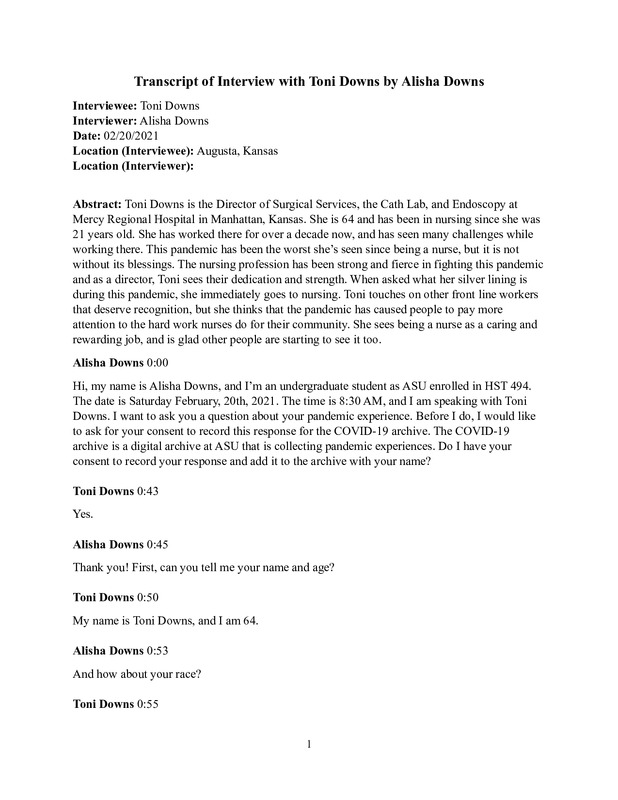
02/20/2021
Toni Downs is the Director of Surgical Services, the Cath Lab, and Endoscopy at Mercy Regional Hospital in Manhattan, Kansas. She is 64 and has been in nursing since she was 21 years old. She has worked there for over a decade now, and has seen many challenges while working there. This pandemic has been the worst she’s seen since being a nurse, but it is not without its blessings. The nursing profession has been strong and fierce in fighting this pandemic and as a director, Toni sees their dedication and strength. When asked what her silver lining is during this pandemic, she immediately goes to nursing. Toni touches on other front line workers that deserve recognition, but she thinks that the pandemic has caused people to pay more attention to the hard work nurses do for their community. She sees being a nurse as a caring and rewarding job, and is glad other people are starting to see it too.
-
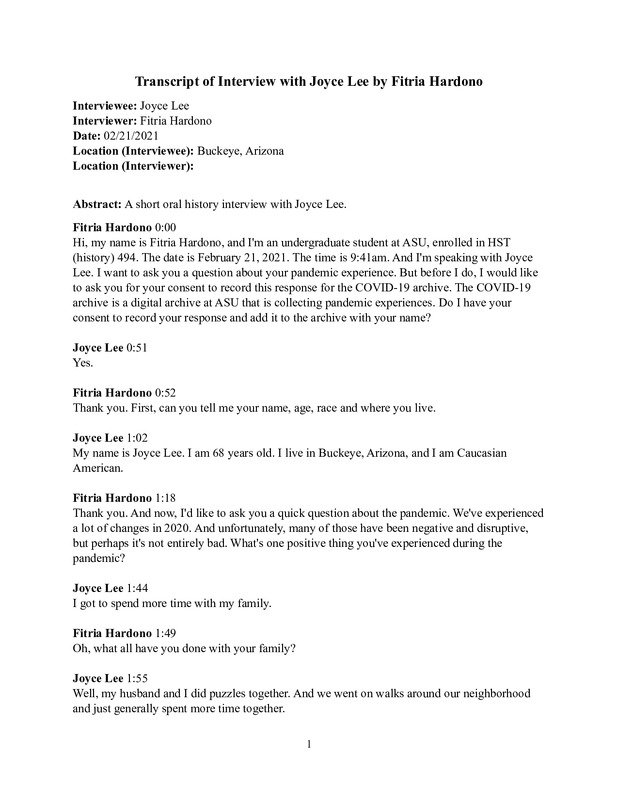
02/21/2021
Mini Oral history interview with Joyce Lee
-

02/18/2021
Maryann Ricketts is a 64 year old woman who resides in Chandler, Arizona with her husband and two loving cats. This pandemic has hit all of us hard but it has hit some of us harder than others. Maryann has been retired for a few years now and has had many hobbies since retiring. Her hobbies include volunteering for homeless shelters, working with animal shelters, and keeping busy with her new grandson. She has always kept busy and this pandemic has made it hard for her to see all her loving friends and family and also keeping busy. She has realized throughout it all that she is very grateful for everyone she has. In this short oral history Maryann explains what something positive is that has come from this pandemic.
-
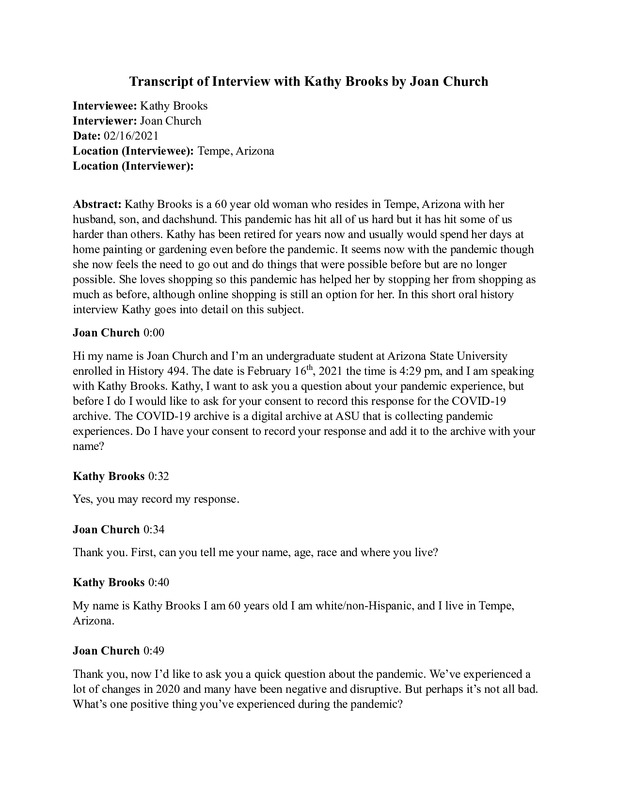
02/16/2021
Kathy Brooks is a 60 year old woman who resides in Tempe, Arizona with her husband, son, and dachshund. This pandemic has hit all of us hard but it has hit some of us harder than others. Kathy has been retired for years now and usually would spend her days at home painting or gardening even before the pandemic. It seems now with the pandemic though she now feels the need to go out and do things that were possible before but are no longer possible. She loves shopping so this pandemic has helped her by stopping her from shopping as much as before, although online shopping is still an option for her. In this short oral history interview Kathy goes into detail on this subject.
-
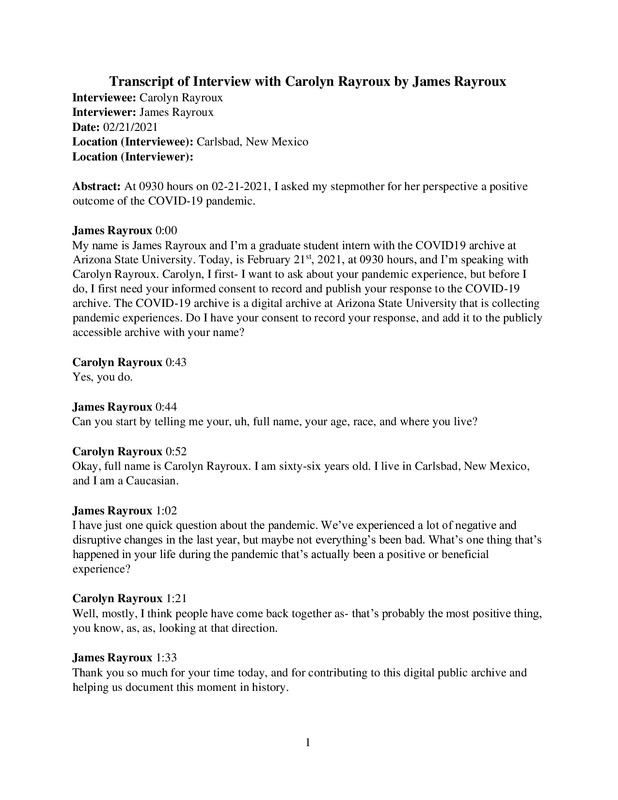
02/21/2021
At 0930 hours on 02-21-2021, I asked my stepmother for her perspective a positive outcome of the COVID-19 pandemic.
-
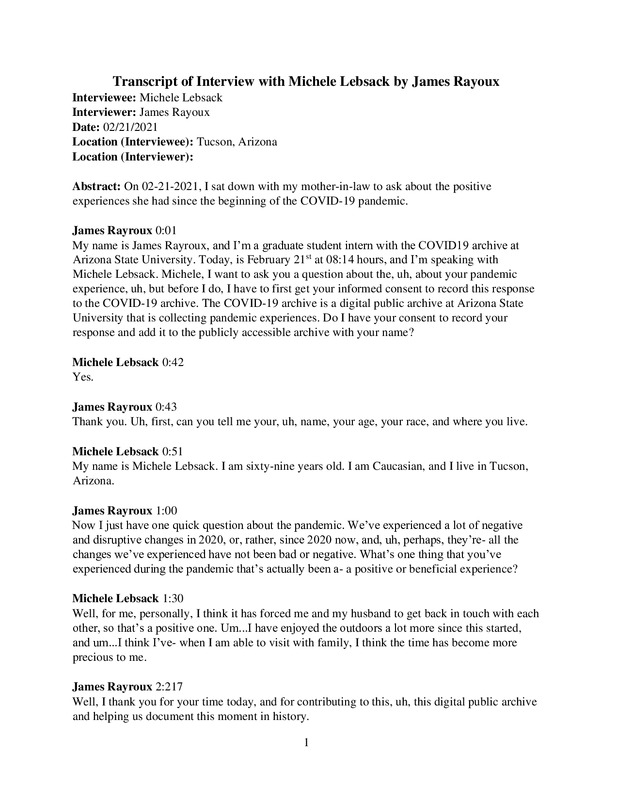
02/21/2021
On 02-21-2021, I sat down with my mother-in-law to ask about the positive experiences she had since the beginning of the COVID-19 pandemic.
-

02/17/2021
This is a mini oral history of Dayna Bowker-Lee by Monica Ruth, about the silver lining of the pandemic experience.
-

02/19/2021
Silver Linings Oral History with Janice Simone Simon
-

2020-02-19
Silver Linings Oral History_ Steven Bell
Interviewee: Steven Paul Bell
Interviewer: Dana Lee Bell
Date of Interview: 02/19/2021
Location of interviewee: Rogue River, Oregon
Location of Interviewer: Fairfield, California
Transcriber: Dana Lee Bell
Abstract: This interview was for the Silver Linings mini oral history project within the JOTPY archive. The interviewer Dana Lee Bell is an intern with the JOTPY archive and is also the daughter of the interviewee Steven Paul Bell. Steven is a wildlife artist residing in Oregon with his wife of 25 years. In the interview Steven talks about how it is nice spending time with family during Covid-19. He also talks of enjoying spending time alone walking and hiking with his dog. Steven had a hard time reflecting on the positive things to say about the Covid-19 experience. Steven Bell is the father of Dana Bell. He thought it very amusing to try and act more formal for the interview.
-
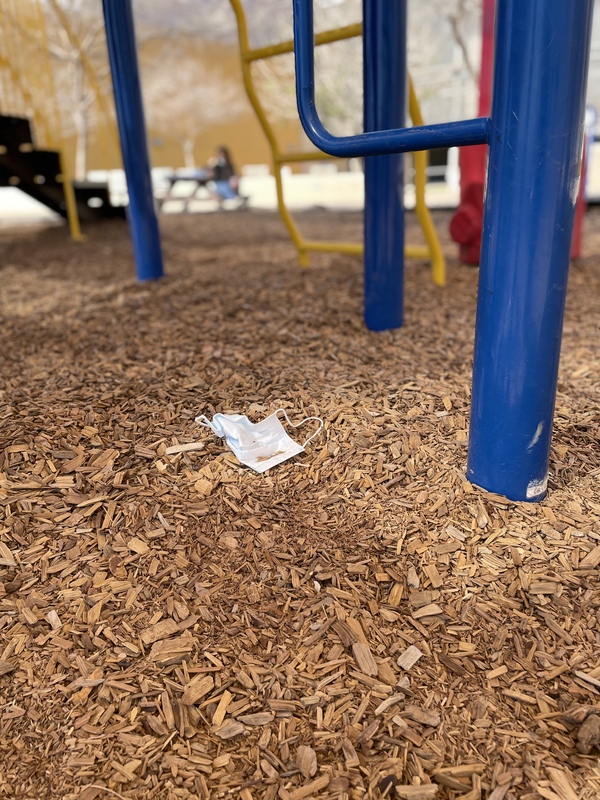
2021-02-20
Mask trash on the playground at the Kroc Center in Phoenix, AZ
-
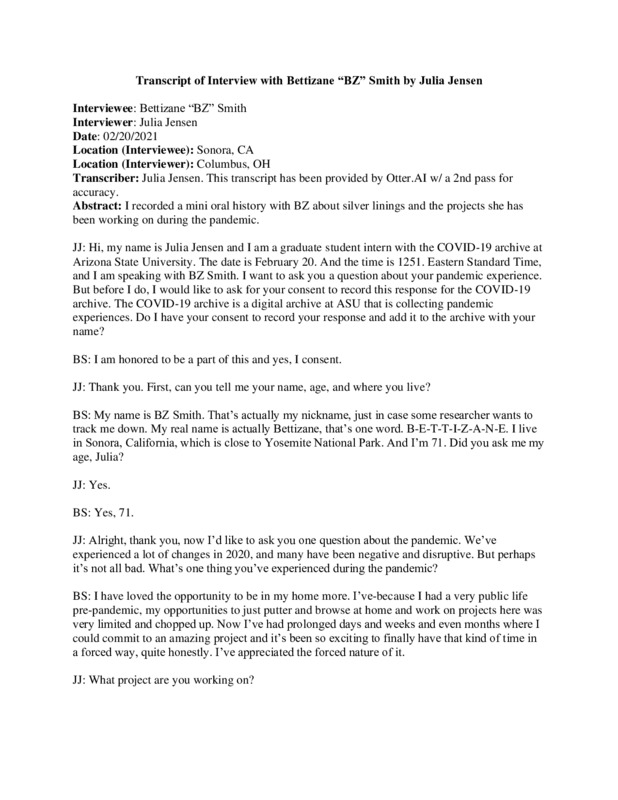
2021-02-20
I recorded a mini oral history with BZ about silver linings and the projects she has been working on during the pandemic.
-
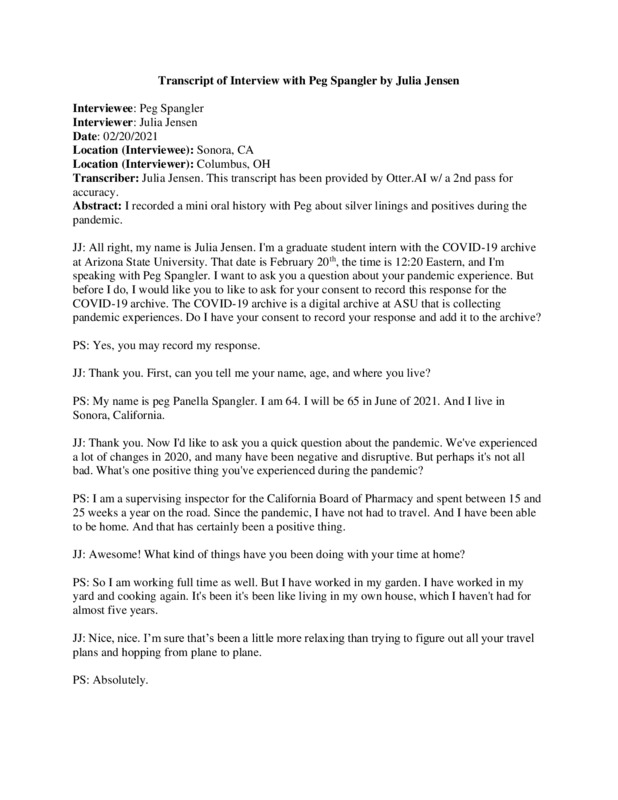
02/20/2021
I recorded a mini oral history with Peg about silver linings and positives during the pandemic.
-

2021-02-20
“Vaccine hesitance among Black people is real but it is NOT the reason why only FIVE PERCENT of vaccinations have gone to the Black community.” This is what the original poster wrote in their social media caption on Instagram.
Many people are justifiably concerned with the current vaccine rollout and accessibility. Multiple people have taken to their respective social media accounts on Twitter to voice their thoughts about it. Vaccine hesitancy was acknowledged by handle @dch1309 as one reason for people not getting vaccinated. However, it seems that this reason is being generalized throughout the entire POC population. In reality, folks like handle @allysonxgill had the impossible task of booking an appointment to get vaccines. Meanwhile, handle @m_jones490 shared their significant other’s experience with an already-booked appointment, yet the site still had organization issues.
I think handle @claudiaalick wrote the core of what I want to say; “The United States must always blame Black people for their own suffering." From these multiple accounts, it’s clear to me that there seems to be an active mission the organizers (government) are on that keep people of color away from even the option of getting vaccinated. Vaccination sites are disorganized and inaccessible to these folks. This happens while non-POC folks fault POC folks for not getting vaccinated at all; victim-blaming at its finest.
-
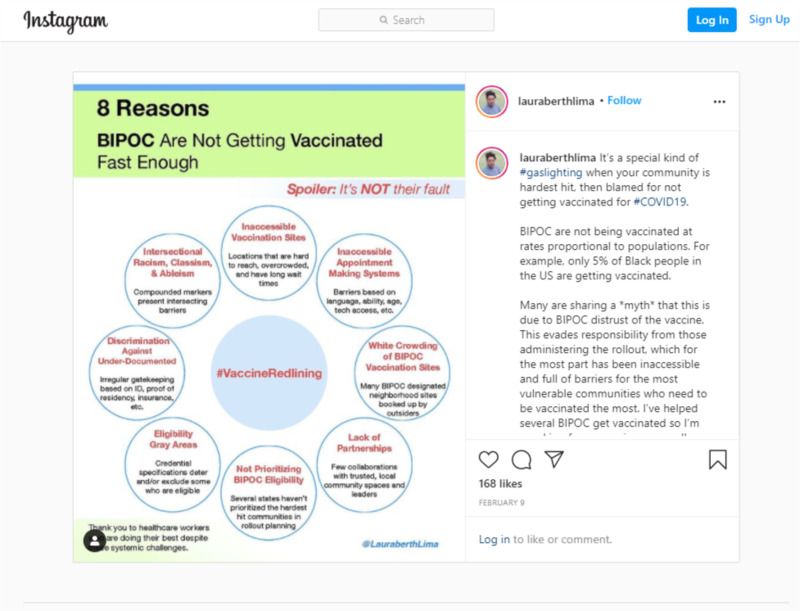
2021-02-20
The following social media post on Instagram by handle @lauraberthlima is an infographic of 8 reasons why BIPOC are not getting vaccinated fast enough. The original poster made it clear that it’s a myth how BIPOC aren’t getting vaccinated due to their distrust, and that it’s actually the difficulty in getting the vaccine. There are a few reasons that are easily guessed, such as inaccessibility and plain racism. However, the graphic and caption explain the reasons a bit more. That includes how the BIPOC-designated sites for vaccinations are being booked by non-BIPOC folks; leaving the BIPOC population without a place to get vaccinated.
Many of the posts on this archive can tell you about the vaccine rollout, how there are goals for herd immunity, and that some people have been getting vaccinated by now. This social media post tells me that BIPOC are not being considered for vaccination, and that the system of vaccine rollout right now is less than ideal. It’s as if the people in charge of the rollout are actively assuring that BIPOC folks do not get the COVID-19 vaccine, and are keeping them at risk by doing so. It’s dangerous and irresponsible, and such posts should be shared to as many people as possible.
-

2021-02-19
ASU is now vaccinating people on campus. Members of the ASU community receive an email when they are eligible. I am eligible and have tried making an appointment twice, but the appointments are always full. After you get a vaccine, employees are supposed to upload a copy of their vacine to an ASU website.
-
2021-02-18
I moved into a place that is walking distance to the famous Trader Joe's. While I don't necessarily buy into the hype and cult-like fanbase around it (there is an entire subreddit dedicated to just posting about things people hauled from Trader Joe's!), I definitely understand the appeal. Even with COVID, the employees are still chipper and friendly as they say. My Trader Joe's is located right next to my university, and I imagine it gets a lot of foot traffic every day. Every time I go, while not necessarily always packed, the store always has people milling around. Perhaps the small store size and narrow aisles make it seem busier than it already is.
Despite this, the store is reasonably socially distanced, and everyone wears a mask. There are employees stationed at almost every part of the store, including the entrance, so safety precautions are well maintained.
With its vast assortment of unique products, Trader Joe's will still be overwhelming to me, but I look forward to exploring more of the private-label brand.
-
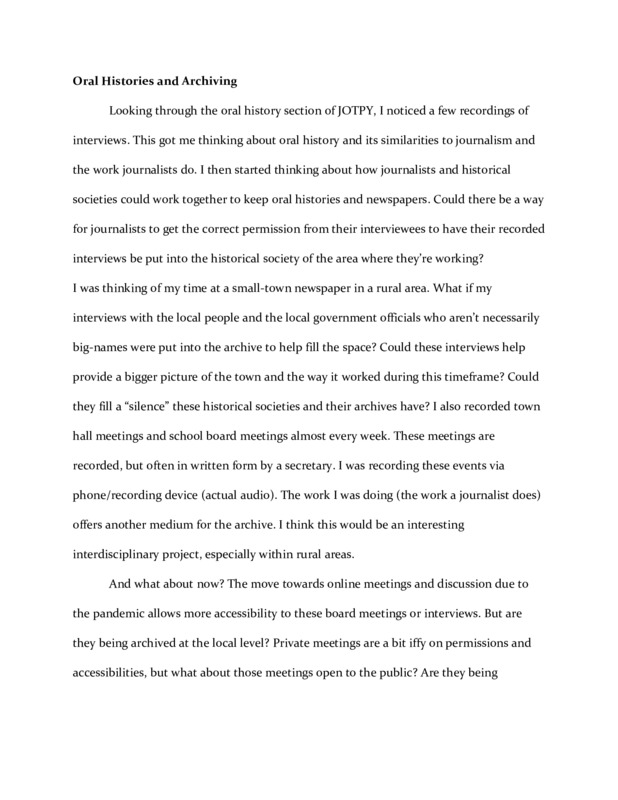
2021-02-11
Looking through the oral history section of JOTPY, I noticed a few recordings of interviews. This got me thinking about oral history and its similarities to journalism and the work journalists do. I then started thinking about how journalists and historical societies could work together to keep oral histories and newspapers. Could there be a way for journalists to get the correct permission from their interviewees to have their recorded interviews be put into the historical society of the area where they’re working?
I was thinking of my time at a small-town newspaper in a rural area. What if my interviews with the local people and the local government officials who aren’t necessarily big-names were put into the archive to help fill the space? Could these interviews help provide a bigger picture of the town and the way it worked during this timeframe? Could they fill a “silence” these historical societies and their archives have? I also recorded town hall meetings and school board meetings almost every week. These meetings are recorded, but often in written form by a secretary. I was recording these events via phone/recording device (actual audio). The work I was doing (the work a journalist does) offers another medium for the archive. I think this would be an interesting interdisciplinary project, especially within rural areas.
And what about now? The move towards online meetings and discussion due to the pandemic allows more accessibility to these board meetings or interviews. But are they being archived at the local level? Private meetings are a bit iffy on permissions and accessibilities, but what about those meetings open to the public? Are they being recorded and then placed where others can access it, and then is the local town historian or historical society archiving it as well? If they are, how are they doing it?
-
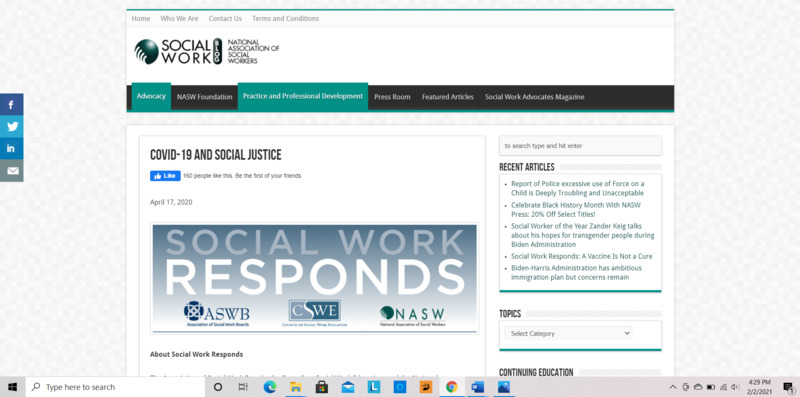
2020-04-17
From the article: The COVID-19 pandemic is a health and mental health crisis, to be sure. But it is also a crisis of social injustice, inequitably affecting vulnerable and marginalized populations that include, among others, individuals who earn low incomes, or are incarcerated, homeless, in foster care, over 65 (especially those in long-term care facilities), people of color, or undocumented. Social work practitioners, educators, and policy makers are working to address the needs of these populations despite the unpredictability of the virus’s secondary impact on systems.
-
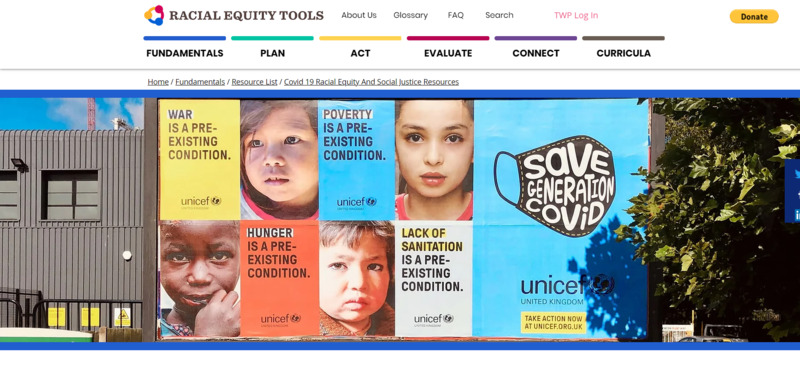
2020
The Fundamental Equity Tools website has resources and tools for people looking to get involved with social justice issues surrounding Covid-19.
-
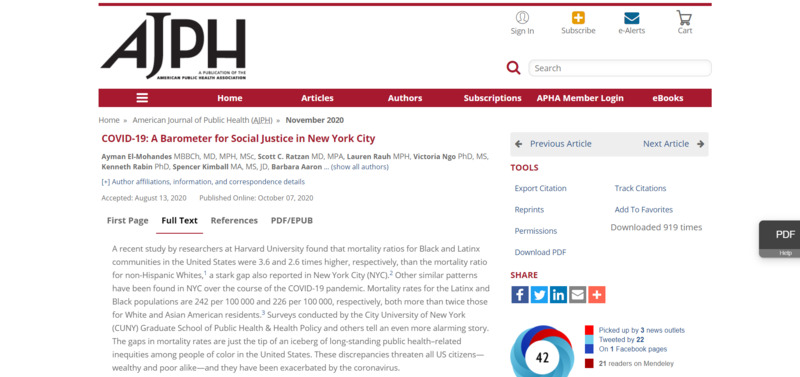
2020-10-07
From the article: A recent study by researchers at Harvard University found that mortality ratios for Black and Latinx communities in the United States were 3.6 and 2.6 times higher, respectively, than the mortality ratio for non-Hispanic Whites,1 a stark gap also reported in New York City (NYC).2 Other similar patterns have been found in NYC over the course of the COVID-19 pandemic. Mortality rates for the Latinx and Black populations are 242 per 100 000 and 226 per 100 000, respectively, both more than twice those for White and Asian American residents.3 Surveys conducted by the City University of New York (CUNY) Graduate School of Public Health & Health Policy and others tell an even more alarming story. The gaps in mortality rates are just the tip of an iceberg of long-standing public health–related inequities among people of color in the United States. These discrepancies threaten all US citizens—wealthy and poor alike—and they have been exacerbated by the coronavirus.
-
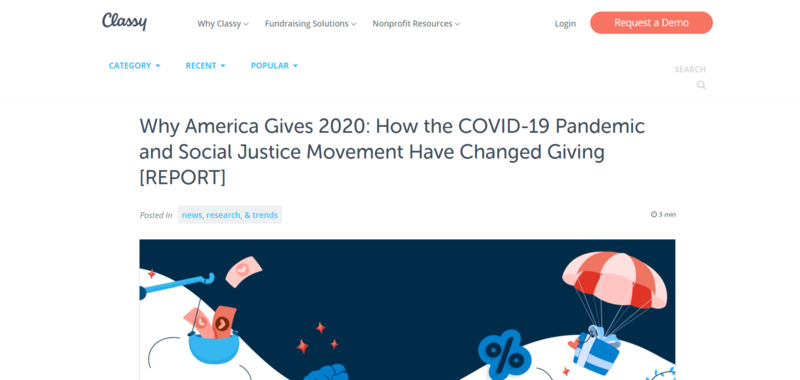
2020-11-19
From the article: In previous years, Classy’s Why America Gives report has focused on consumer giving trends, what motivates donors to give, and their plans for Giving Tuesday and year-end giving. In our third-annual edition of Why America Gives, the 2020 report measures these year-over-year changes in giving sentiments and behaviors; in addition, it also analyzes how current events—specifically the COVID-19 pandemic and the social justice movement—have altered giving trends.
-

2020-10-29
2020 was a good time for video games, particularly those that I am interested in. Releasing in the middle of the year, games such as the highly anticipated Mount and Blade: Bannerlord and Crusader Kings III managed to provide time-wasting opportunities to many people. The latter, abbreviated CK3, is pictured here. CK3 is essentially a feudalism-simulator with role playing game mechanics, famous in the PC gaming sphere for both its complexity but also its ability to organically allow stories to form in the most Game of Thrones way possible.
This was one of my earlier games, after I was more familiar with how the game differed from CK2. Starting as the Raja of the real-life Northern Indian dynasty of the Imperial Gurjara-Pratihara in 867 CE, through many generations of rulers I managed to consolidate the entire subcontinent through diplomacy, intrigue, and warfare. Around 1000 CE one of my rulers who had a more intellectual education rather than the usual military one, consolidated all imperially sanctioned Hindu beliefs into the Charvaka school, a real-life ancient Hindu belief based on materialism and empiricism. As this new consolidated Hinduism united the subcontinent at a more local level, regional governors along the Indus River took advantage of political fragmentation around the Indian Ocean and pushed west, taking over not just Persia and Central Asia but also establishing Hindu-Somali outposts in Africa and Yemen. By the 1300s the empire spread from Burma in the east all the way to modern day Libya and Greece, with Rome itself falling to a Pratihara expedition. Peace was maintained within the empire's vassals by a robust series of alliances, as well as the use of the "dread" mechanic to scare any more unruly subjects into submission via planned executions and threats. The most serious threats the Pratihara Empire faced was a series of crusades launched from Western Europe, and the Mongol Conquests which were ended by assassinating a few generations of Mongol Khans leading to political infighting and collapse.
Beyond the fake history being made in game, this single play through gave me enjoyment for dozens of hours. While psychical entertainment was shut down, travel impossible, and the shadow of the pandemic hung over everything, games like CK3 allow people like me to immerse ourselves in what begins as real history and ends with an alternate history that we ourselves designed. Many people who don't usually play video games became engrossed in them, particularly early on in the likewise open-ended game Animal Crossing: New Horizons. The need to develop new hobbies as a way to cope with isolation was a boon for the video game industry, which despite its massive market was seen by many people as quaint at best, or worthless at worst. There is value in video games, especially during the pandemic.
-
2021-02-18
I received my second vaccination earlier this week. I had minor symptoms (some fatigue and body aches), but otherwise it went well. I had some friends, both in exceptional shape, who experienced high fevers and other flu like symptoms, so I guess I lucked out on that front. The peace of mind is incredible. I plan to still take precautions, especially because even with the vaccine, it is believed you can still carry the virus, but it is wonderful to not have to worry about getting sick with COVID anymore.
-
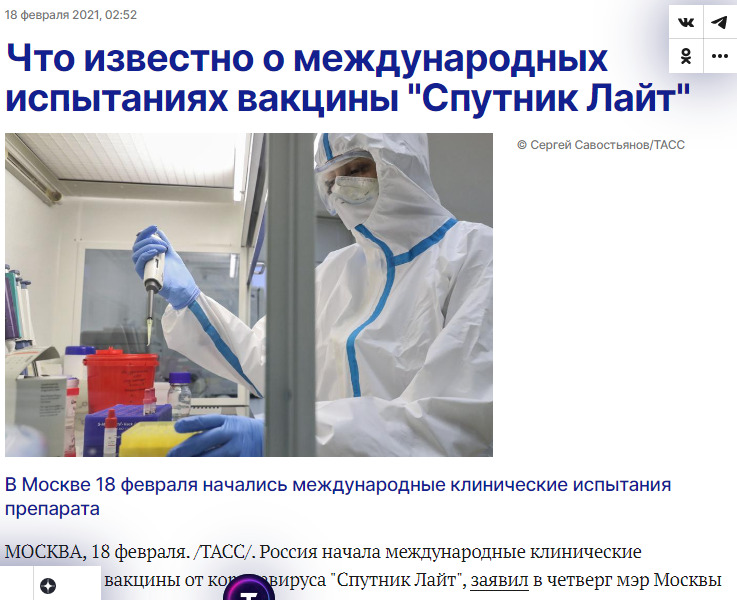
2021-02-18
It is an article about an innovative vaccine from COVID that is not two-phased, but one-phased.
-
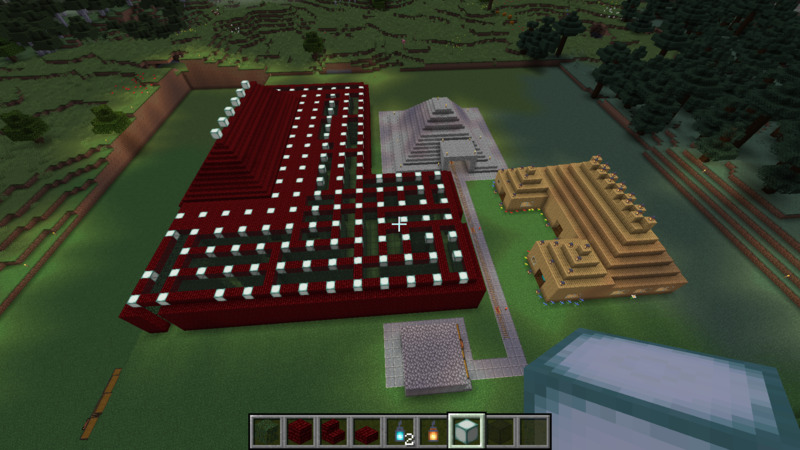
2021-02-16
This is the creative project I've been working on in Minecraft to handle the stress of attending grad school during the Covid19 pandemic. Minecraft and other video games have been sources of stress release and social interaction since forced isolation/quarantine and restrictions on social gathering has resulted in more people playing games and joining online communities for the needed social interaction for the maintenance of their mental health.
-
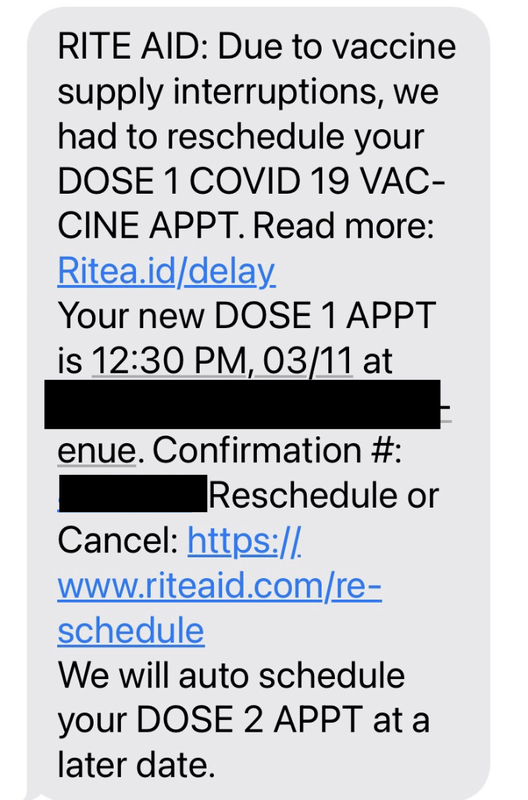
2021-02-17
My homeland, Orange County, has not been a place to be very proud of during COVID-19. Between anti-maskers, inept leadership, lack of transparency, and inequity in access to both COVID-19 testing and vaccines, this year has been a roller coaster in our little coastal chunk of CA. The vaccine roll out has been a massive headache. For the past month on Instagram, I see post after post of people younger than I who are getting their vaccinations because they live in another part of the state or country, while locally it's only health care workers I know that have been able to be vaccinated. Although other parts of CA (and the country) have begun to vaccinate teachers and food workers, Orange County is stubbornly (as I was told in a meeting today) waiting until 50% of the over 65 population is vaccinated before they open it up to the next tier. Though this causes me endless anxiety - will I be able to get a vaccine before my high school of 2500 opens for in person instruction - the one relief of the week was that my 65 year old mother was FINALLY able to get a vaccination appointment. The Othena system is a joke - she tried numerous times and couldn't get an appointment for the supposed super pods. Kaiser is still only vaccinating 75+! The Nextdoor app clued us in that a local hospital (where my mom has her insurance) was starting to vaccinate. Despite logging on in the very beginning of February, the earliest appointment she could get is for March 3. She took it, but I wanted to keep searching, because I worry that if the next Tier opens, she may have trouble getting a second shot if she waits until March 3. Nextdoor again clued me in to Rite-Aid, where a friend of my mom's outside OC got her vaccine. Best part - you go directly through Rite Aid, so no Othena! Success! My mom made her appointment on Saturday for tomorrow. We were jubilant! I told both my best friends about the Rite Aid trick, and within three days, they had their elderly family members signed up. Today, an hour after my best friend texted me that her dad got his Rite Aid vaccine, my mom sent me her cancellation message. Apparently the current winter storms have delayed the arrival of vaccines. My mom got lucky again, because it turns out that our school district is vaccinating employees 65+. Though retired, because she is a part time employee, my mom received an invitation today. Once she got the Rite Aid cancellation, she made her an appointment with the school district. Tomorrow is the first day the school district is vaccinating, so we have no idea what to expect, and are a little nervous because her insurance is not one of the carriers of the school district. Fingers crossed that she can still get it! Though I am genuinely happy for everyone getting vaccinated, it is frustrating that it is so much work here to try and get one. Using the Othena site hasn't worked for anyone I know - everyone I know has been vaccinated through their work or somewhere like Rite Aid. Honestly, if I see another post of someone with their vaccination card with a "do your part!" message I am going to throw my phone at the wall. I do want to do my part, if only Orange County would get their act together and manage this whole roll out better. Come on Orange County, you can do better.
-
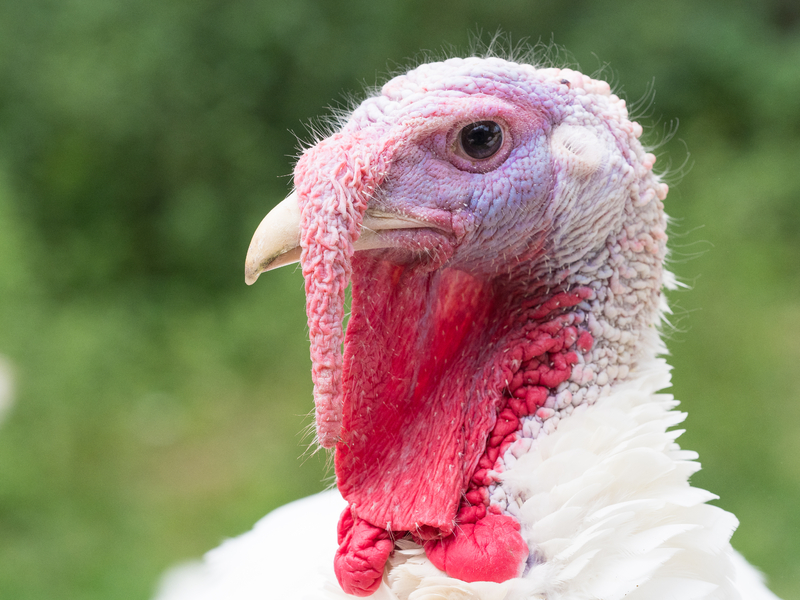
2021-02-17
Many years ago, there was a public service ad that said ‘This is your brain on drugs.” It featured an egg cracking into a frying pan, sizzling crisply. I feel the same way about my neck on zoom. It is a horrifying sight. For many of us, ZOOM is the funhouse mirror we do not wish to look into. It has been suggested that staring at ourselves on ZOOM calls sucks the life out of our brains and that it might be better to simply not be able to see ourselves. Apparently, you can block yourself from being able to see your own face while allowing your fellow ZOOM-ers to gaze at you. Honestly, that seems worse to me. What if I look like a Salvador Dali painting? And what about my NECK? Chin high, neck elongated is my mantra. Channeling Audrey Hepburn helps. Otherwise, I look like a candidate for a Thanksgiving carving board. This is what COVID hath wrought. Not a fear of disease or death (although THAT is responsible for the extra furrows between my brows), but a conversation about inner beauty and wisdom vs. gravity and slackness of skin.
For women of a certain age COVID has brought a dollop of fear, and a hefty helping of self-pity at the mere thought of newborn grandchildren we cannot hold. And it has also rendered us as insecure and self-conscious as a teenager with a pimple on the tip of the nose. The state of the skin beneath my chin should not matter, and yet it does.
-
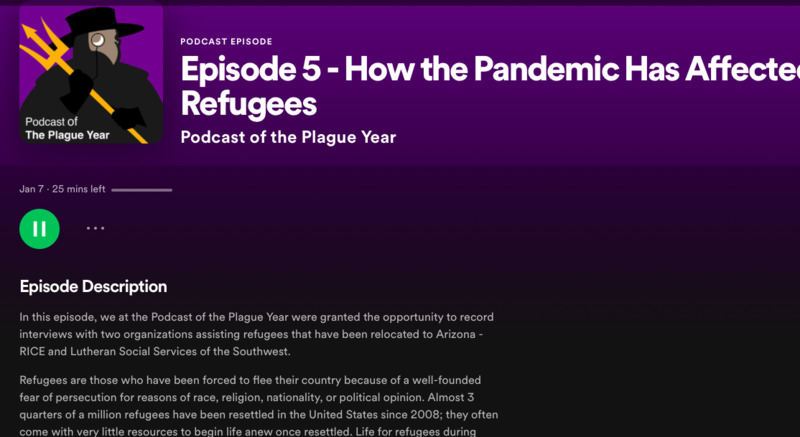
2021-01-07
In this episode, we at the Podcast of the Plague Year were granted the opportunity to record interviews with two organizations assisting refugees that have been relocated to Arizona- RICE and Lutheran Social Services of the Southwest.
Refugees are those who have been forced to flee their country because of a well-founded fear of persecution for reasons of race, religion, nationality, or political opinion. Almost 3 quarters of a million refugees have been resettled in the United States since 2008; they often come with very little resources to begin life anew once resettled. Life for refugees during resettlement comes with hope, but also with struggles to learn a new language, navigate new employment and educational systems and integrate into a new society. It is easy to imagine how a pandemic could intensify already existing struggles.
-

2021-02-09
In a time when people can't go to museums or concert halls, arts and musicians are improvising. Many are taking part in digital exhibitions and performances. Others are embracing the practice of street art, it always artists to continue creating art and have more exposure to the general population.
-
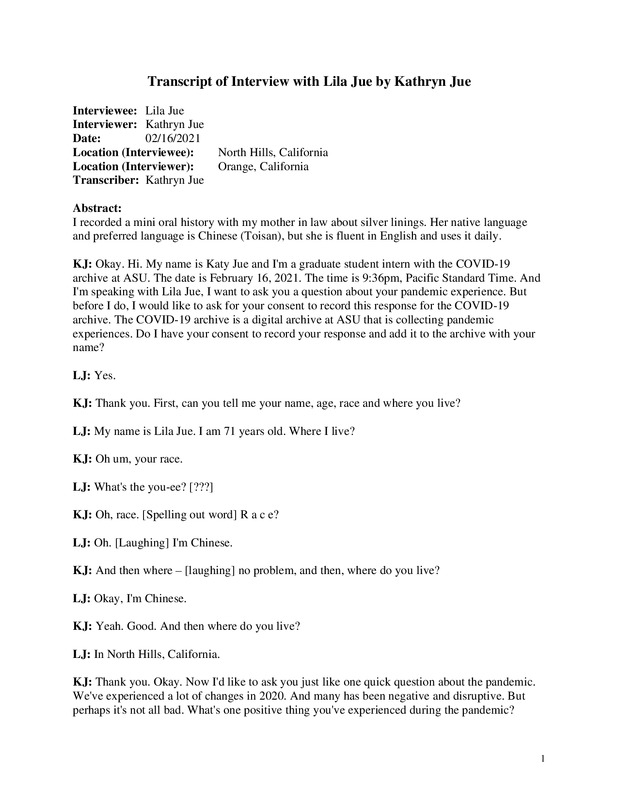
02/16/2021
I recorded a mini oral history with my mother in law about silver linings during the pandemic. The photograph is a family Zoom, as this is a positive of the pandemic year to her.
-
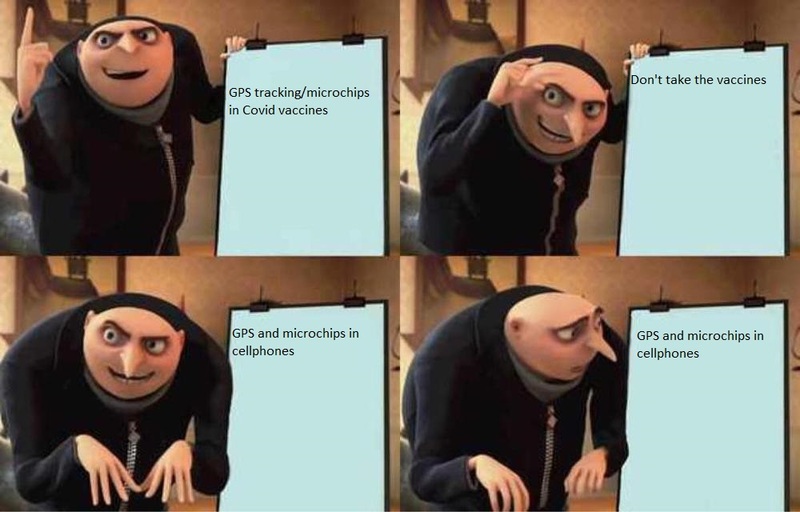
2021-02-16
A meme that questions one of the fears surrounding the Covid-19 vaccine.
-
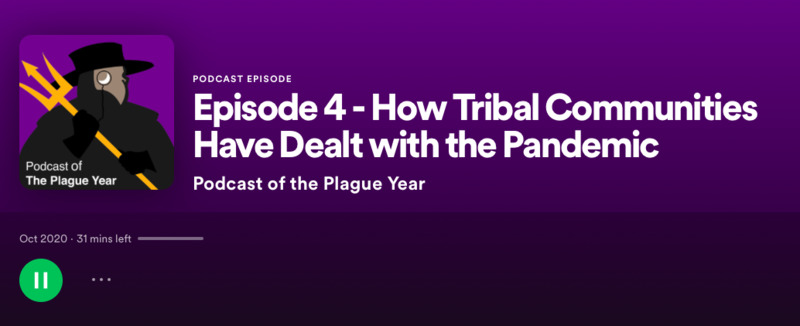
2020-10
A cursory look into A Journal of the Plague Year reveals that the pandemic is nondiscriminatory, all of are affected. Yet, the reality is that Covid-19 is having more impact on certain populations in American communities. Arizona State University's Center for the Study of Religion and Conflict partnered with the Henry Luce Foundation to provide rapid relief funding to marginalized communities in the southwest. As part of the rapid relief program, the Center for the Study of Religion and Conflict is collaborating with A Journal of the Plague Year and the Walter Cronkite School of Journalism and Mass Communication to raise awareness about the marginalized communities that were assisted via this grant.
By joining this "Southwest Stories" project, we at the Podcast of the Plague Year were granted the opportunity to spotlight one Native American community in Arizona- the White Mountain Apache Tribe.
-

02/16/2021
I recorded a mini oral history with my mom's old friend about the positive aspects she experienced during the pandemic
-
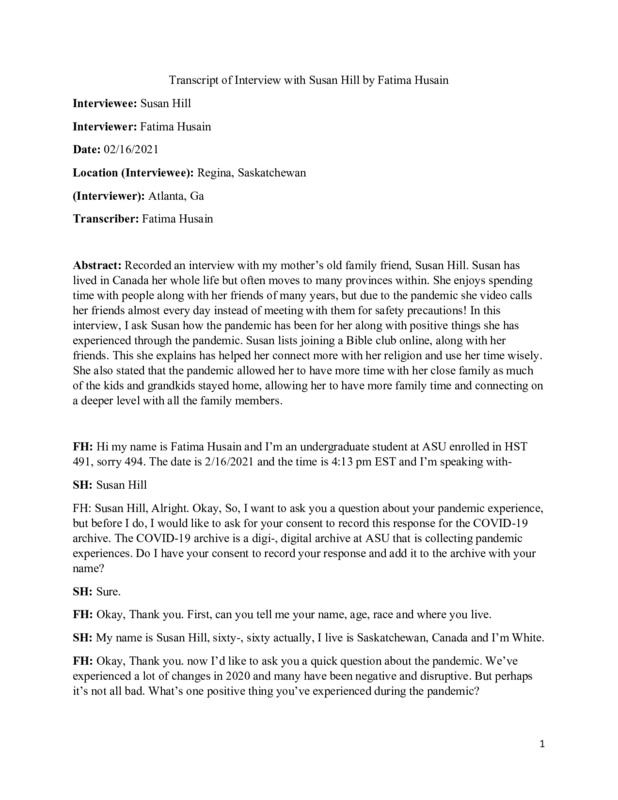
02/16/2021
I recorded a mini oral history with my mom's old friend about the positive aspects she experienced during the pandemic
-

2021-02-16
Truckers are not being tested or facing restrictions like other cross-border travelers. This has led to some push back as they likely see more interactions with others than other travelers, including non-essential travel such as recreation. There are talks to either require quarantine and possibility to prioritize truckers for the Covid-19 vaccine.
-
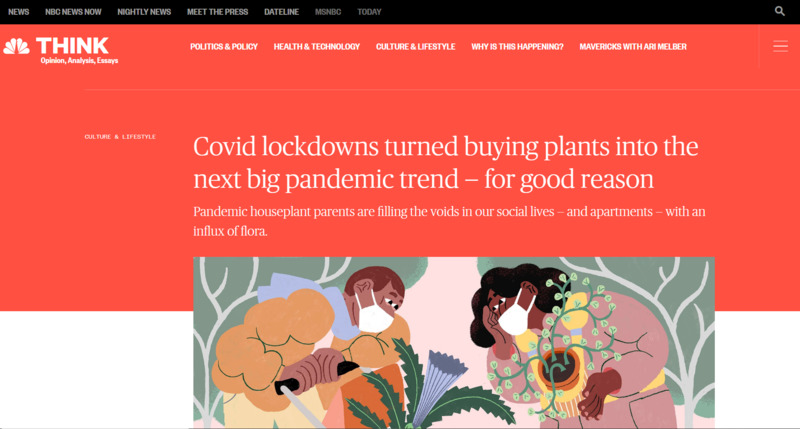
2021-01-30
During lockdowns, people have taken to keeping houseplants as companions. These plants help people that live alone feel less lonely and ground them. People have had varied results with their plants, but plant influences have seen a surge in people asking for help with their plants.
-
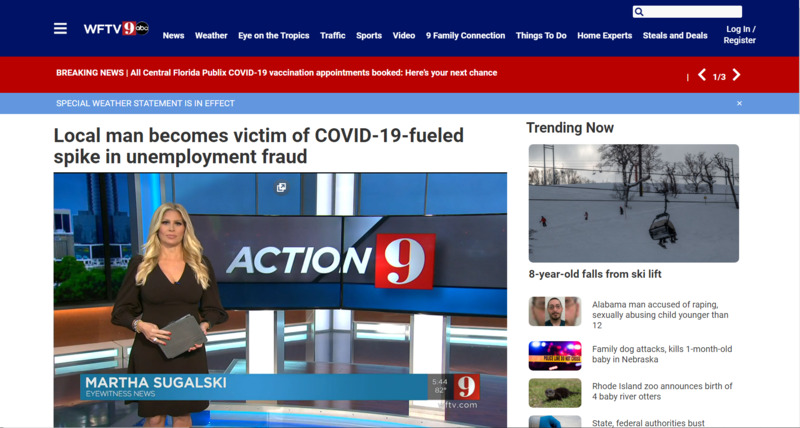
2021-02-12
Along with COVID-19 came a spike in identity theft. These thieves then use the stolen information to apply for COVID-19 unemployment benefits. In some cases, the states try to get the victims to pay back the money given to the thief.
-

2020-12-19
The news story is both an interview with a street artist in New York and an exploration of how street art has taken off in New York as a result of the pandemic. The artist and the article report that many businesses have boarded up their windows and vacated, leaving a lot of unattended public space for artists to occupy, especially for illegal graffiti. Not everyone supports the increase in graffiti and street art, as other residents complain about the graffiti-related crime and vandalism.
-
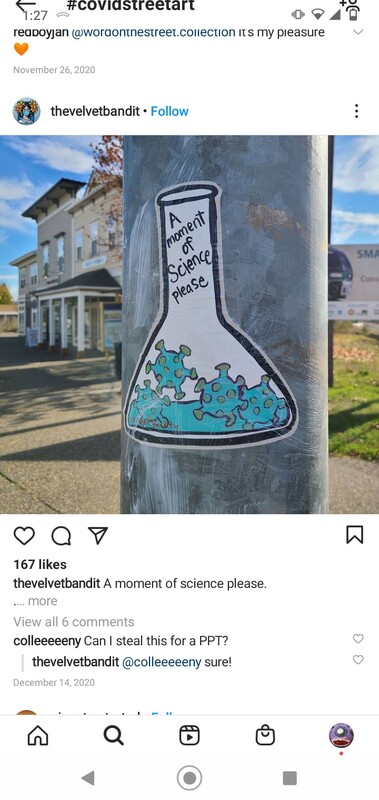
2020
This Instagram post was made by the street artist Velvet Bandit of their work depicting a chemistry beaker with cartoon style viruses inside. The message, "A moment of science please," is a play on a well-known phrase "a moment of silence, please" that is used in gatherings to honor people that have died. Hundreds of thousands of people have died from the pandemic and this street art is making commentary on pandemic deniers.
-
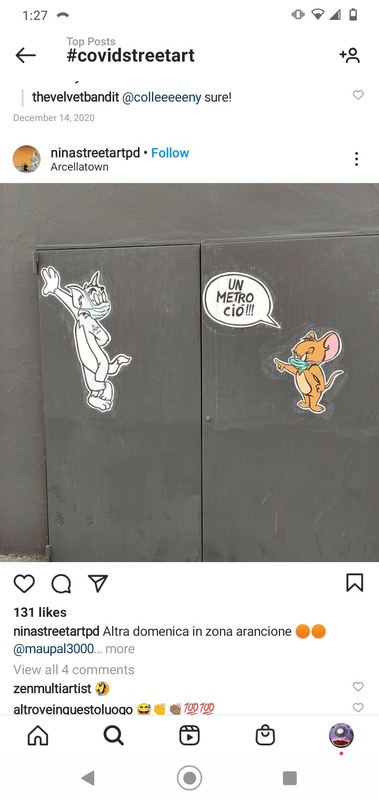
2020
This post is a picture of paste up of well known cartoon characters Tom and Jerry. Both are wearing masks and Jerry is telling Tom, "That's one meter!" in Italian.
-
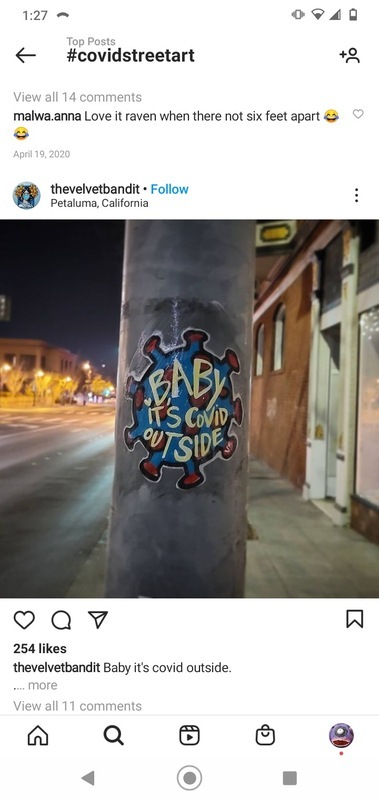
2020
This post was made by the street artist, Velvet Bandit, of their past up on a pole in Petaluma, California. The artwork is a cartoon virus with the message "Baby it's covid outside" over it.
-
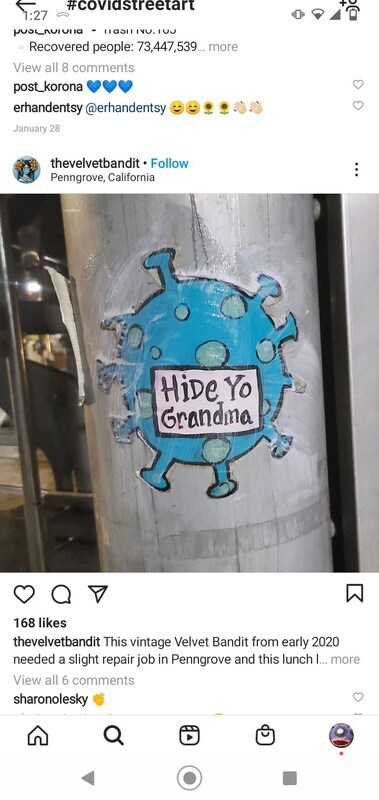
2020
This post is by the artist Velvet Bandit of their street art pasted on a pole. The work is a cartoon image of the virus with a text box reading, "Hide Yo Grandma."
-
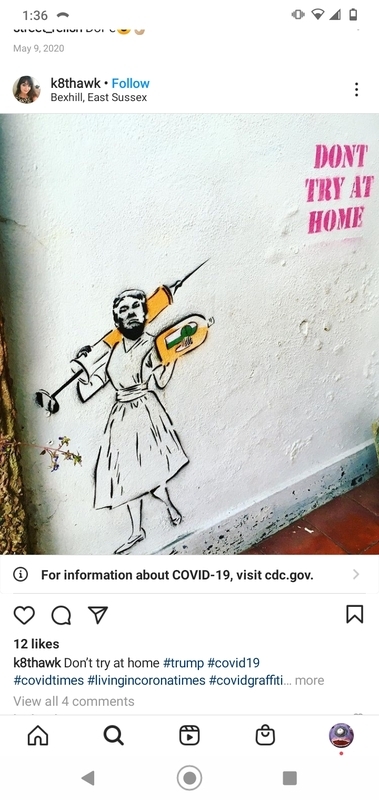
2020
This is an Instagram post of street art in Bexhill, East Sussex. The street art is a stencil of US President Trump as a nurse with an oversized syringe and the phrase, "DONT TRY AT HOME." This is a reference to comments made by Trump to try injecting bleach as a remedy for the coronavirus.
-
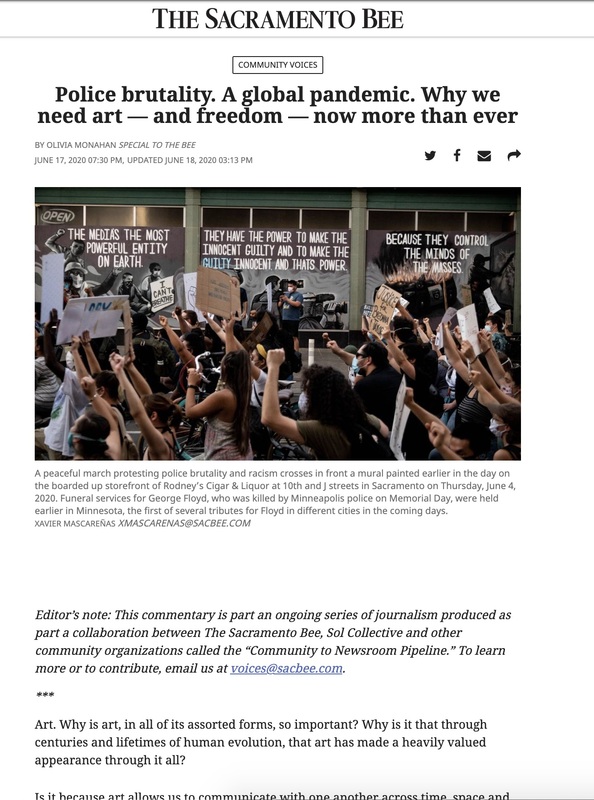
2020-06-17
This article explores how street art expresses community sentiment in a public arena, as expressions of emotion, desire, creativity, and human rights.
-
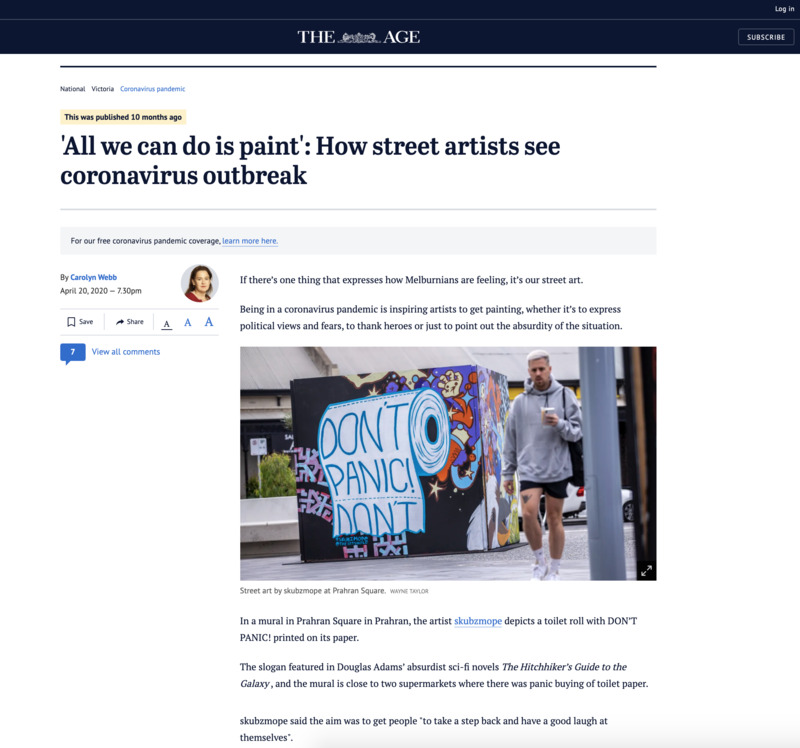
2020-04-20
This article quotes several street artists about how the pandemic has impacted their art and their messages. The direct quotes amplify their messages, although the street art speaks volumes in its public arena.
-
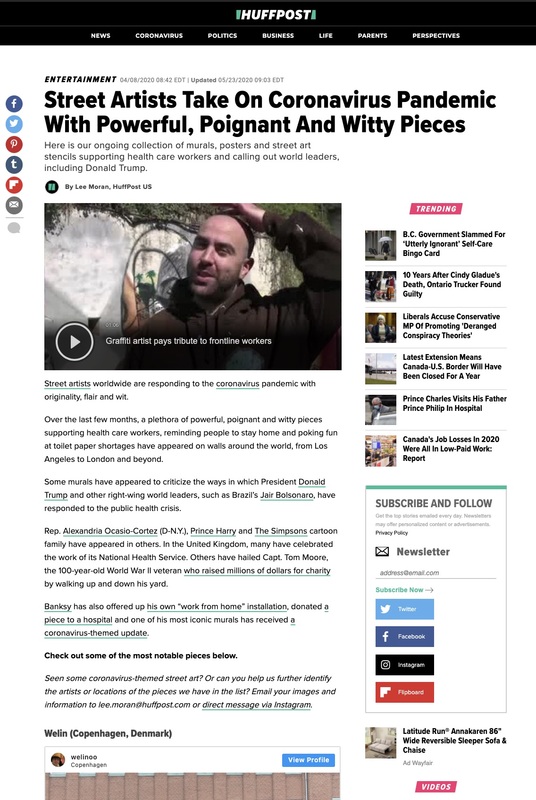
2020-05-23
This article talks about street art around the world responding to the pandemic with satire, humor, political commentary, observation and expression. What stands out most with this article is the video interview of a street artist while he is completing a piece of art honoring frontline workers.
-
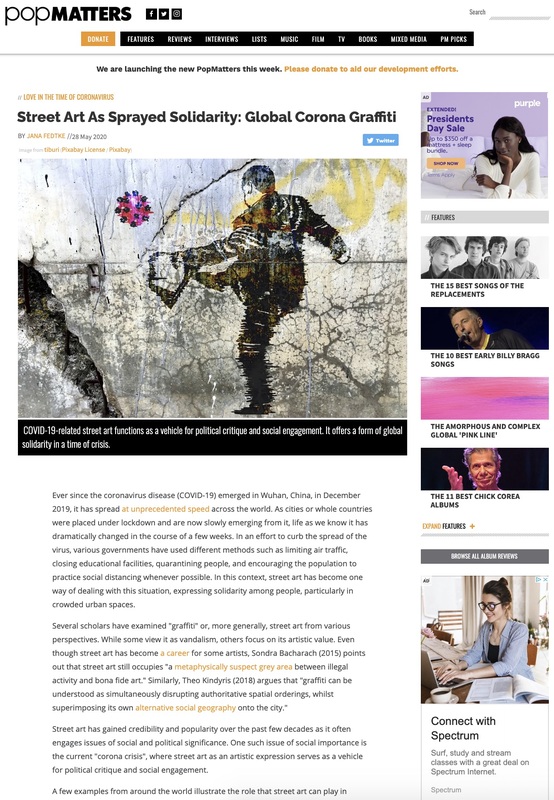
2020-05-28
This article, written by Jana Fedtke for PopMatters, describes instances of worldwide street art as political critique and social engagement during the pandemic. Examples of street art shown include stencil work. The author explores the ways in which street art relay information about how government agencies have handled spreading information and health care and in turn, how street artists depict social engagement with pandemic procedures.
-

2021-02-12
This Year of the Ox is coming in much differently than the Year of the Rat. Last year, with the smallest shadow cast over the new year with news of a SARS type virus spreading through China, we were still able to celebrate normally, and thought those who had taken to wearing masks were exaggerating the seriousness of the disease. We had new year’s dinner with family, the kids wore their traditional outfits to school and fed red envelopes to the lion dancers, the city held their annual parade, and we even celebrated at Disneyland’s California Adventure, with local community groups coming in to perform and celebrate. Whether you say “新年快乐,” “Chúc Mừng Năm Mới,” or simply “Happy New Year,” Lunar New year is a huge celebration in our community and that celebration certainly isn’t happening in the same way this year. However, even though it’s tempting to focus on the fact that we’re sequestered at home and are physically separated from family, friends, and big celebrations, there is much optimism with the hope of the vaccine. All day, my phone’s been buzzing with new year messages, most of which end with “may the new year bring better tidings” or “may this new year bring much health.” Even talking to my in-laws for the new year today had an extra sense of joy, because they shared they are getting their second dose of the vaccine on Thursday. With light at the end of the tunnel, we are able to talk for the first time about maybe being able to see each other in person by the spring. When my son played piano for them virtually, I imagined it won’t be too long until these FaceTime visits will be replaced by the real thing. So here’s to the new year - may we all see health and peace.
-
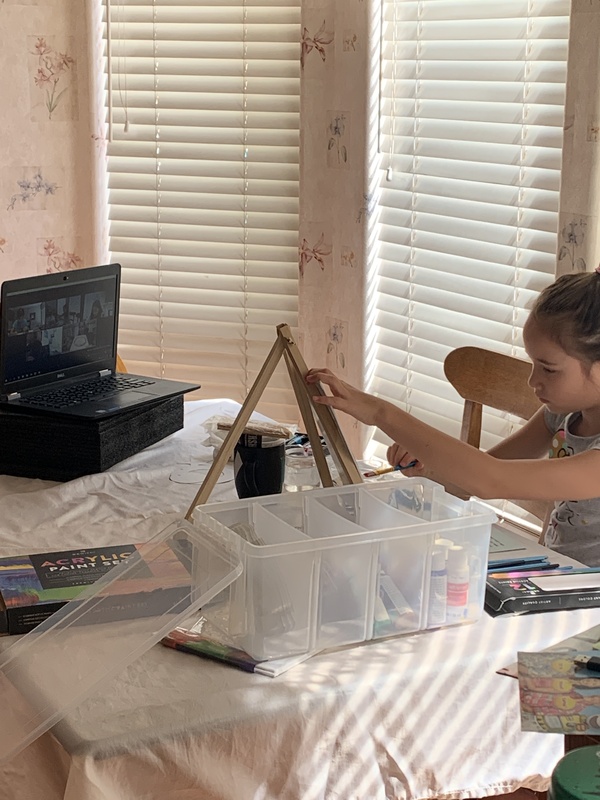
2020-12-06
When my daughter's birthday arrived this past summer, we realized any in person party was out of the question. Trying to think of what we could possibly do, we reached out to our friend, a part-time artist, and asked if she would mind hosting a virtual painting party for our daughter and three of her friends to do over Zoom. Our friend was amazing, leading the girls in painting a Captain America shield. She made my daughter's birthday quarantine memorable and fun. Three months later, and desperate for ways to make our virtual Girl Scout meetings exciting, I asked if she would consider leading our girls in earning their "Drawing" badge. Not only was she excited, she went above and beyond. Her husband, who does tech work for films (including the Mandalorian) set her up with various camera angles she could toggle back and forth through. She didn't just have the girls copy a picture, she taught them about all the different tools, how to shade, different techniques. Honestly, I learned a lot myself! Though she did this out of the kindness of her heart, I seriously think she should make a career out of this! She was amazing with the girls, they LOVED the meeting and talked about not only how much they learned, but how helpful and patient our special guest teacher was. She really should start an art for kids YouTube channel. One of the greatest things that has come out of this pandemic is the willingness of people to assist and support one another, and use their talents in ways that they may not have thought of before.
-
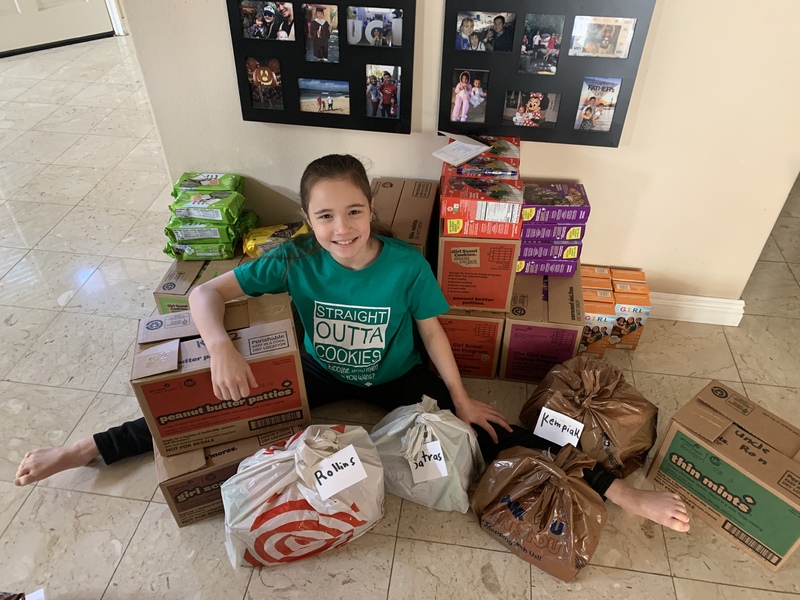
2021-01-11
The one thing people seem to know about Girl Scouts is they sell cookies. What people don't know is that the profit from the cookie sales is how troops pay for their activities and service projects. My daughter has loved selling cookies since she started Girl Scouts in kindergarten. For the past three years, she has sold over 1,000 boxes a year, which is a crazy amount of cookies to sell! Of course, having a mom who has an entire high school student body to sell to, and a dad who has an entire college campus to sell to doesn't hurt. This year, both her parents are working virtually, which means her customer pool has shrunk considerably. The Girl Scouts, knowing how important cookie sales are to the girls, moved the sale online. To try and drum up sales, my daughter created an online sales pitch to send to friends and family, and post on our social media along with her personalized link to sell her cookies. We are all completely shocked that she has managed to sell over 500 boxes through this platform. I am so proud of her, and all our girls who have worked to achieve their two profit goals: first, to buy supplies and fund activities for another troop in our area that is run out of a local rescue mission and serves girls experiencing homelessness, and second, to go horseback riding.
 02/20/2021
02/20/2021 02/21/2021
02/21/2021 02/18/2021
02/18/2021 02/16/2021
02/16/2021 02/21/2021
02/21/2021 02/21/2021
02/21/2021 02/17/2021
02/17/2021 02/19/2021
02/19/2021 2020-02-19
2020-02-19 2021-02-20
2021-02-20 2021-02-20
2021-02-20 02/20/2021
02/20/2021 2021-02-20
2021-02-20 2021-02-20
2021-02-20 2021-02-19
2021-02-19 2021-02-11
2021-02-11 2020-04-17
2020-04-17 2020
2020 2020-10-07
2020-10-07 2020-11-19
2020-11-19 2020-10-29
2020-10-29 2021-02-18
2021-02-18 2021-02-16
2021-02-16 2021-02-17
2021-02-17 2021-02-17
2021-02-17 2021-01-07
2021-01-07 2021-02-09
2021-02-09 02/16/2021
02/16/2021 2021-02-16
2021-02-16 2020-10
2020-10 02/16/2021
02/16/2021 02/16/2021
02/16/2021 2021-02-16
2021-02-16 2021-01-30
2021-01-30 2021-02-12
2021-02-12 2020-12-19
2020-12-19 2020
2020 2020
2020 2020
2020 2020
2020 2020
2020 2020-06-17
2020-06-17 2020-04-20
2020-04-20 2020-05-23
2020-05-23 2020-05-28
2020-05-28 2021-02-12
2021-02-12 2020-12-06
2020-12-06 2021-01-11
2021-01-11